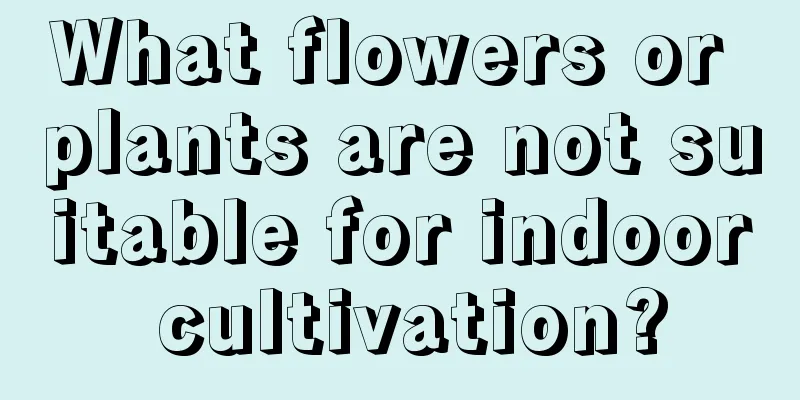What flowers or plants are not suitable for indoor cultivation?

MandalaDatura is like an invisible killer, so never keep it at home. The whole plant is poisonous. First, the fruit and seeds are the most toxic, and second, the young leaves. Even the dried leaves are toxic. Its flowers are also narcotic. If accidentally ingested, they can make people excited and cause hallucinations. Excessive consumption can cause damage to the nerve center and can be life-threatening in severe cases. poppyThe name of the poppy is beautiful and its flowers are gorgeous, and its legend is even more sad and moving, but the whole plant is poisonous. It belongs to the poppy family, and its fruit is extremely toxic. Accidental ingestion can cause brain and nerve dysfunction, and in severe cases can endanger life and health. OleanderThe entire oleander plant is poisonous. If the white juice it secretes is accidentally ingested, it will cause symptoms such as vomiting, loss of consciousness, diarrhea, and respiratory disorders. In severe cases, it can endanger health and life. Especially when burning oleander branches and leaves, the smoke produced is highly toxic. Five-color plumThe five-color plum is cultivated in Guangdong, Hainan, Fujian, Taiwan, Guangxi and other southern China regions. It is a wild flower. The plant itself appears to be non-toxic and harmless, but its flowers, leaves and unripe fruits are poisonous. If accidentally ingested, it can cause serious consequences, such as chronic liver poisoning, with symptoms such as coma, vomiting, diarrhea, fever, jaundice, and shortness of breath. GeraniumGeranium, also known as hydrangea, is the best flower for decorating windowsills and corners, but the substances it emits can cause skin itching after human contact. If the stems and leaves of hydrangea are eaten by mistake, it will cause urgency, hernia, diarrhea, breathing, vomiting, bloody stools, etc. NarcissusDaffodils have a history of cultivation and appreciation of more than a thousand years. Placing them indoors can make people feel warm and peaceful. But its head (scales) contains lacodine toxin. Its flowers, branches and leaves are all poisonous. If the juice splashes on the skin, it will cause the skin to quickly become red and swollen. After poisoning, people will experience abdominal pain, nausea and vomiting. The fragrance of the flowers can also cause disorders in the human nervous system. Inhaling the fragrance for a long time will cause dizziness, and it will be more serious if inhaled before going to bed. PoinsettiaPoinsettia has a long flowering period, and its flowering time is just during Christmas and the Spring Festival. Using it to decorate the room can add a festive atmosphere, but it must not be placed indoors for a long time, because it will release toxic substances that are harmful to the human body. If the milk it secretes accidentally comes into contact with the skin, it will cause an allergic reaction, causing the skin to quickly become red and swollen, and in severe cases, ulcers will occur; if the stems or leaves are accidentally eaten, it will cause abdominal pain and vomiting, and in severe cases it can even be fatal. RoseIn fact, the rose itself is not toxic. It is the irritating smell produced by its overly strong fragrance that can cause respiratory infections, so it cannot be grown indoors for a long time. Yellow AzaleaAzalea, also known as yellow azalea, contains a lot of toxins in its flowers, so don't smell or touch them easily. If ingested by mistake, poisoning may occur, and in severe cases, toxic shock may occur, which is harmful to human health. TuberoseTuberose is a relatively special plant. It can be placed indoors during the day and moved outdoors at night. When there is no sunlight at night, tuberose will release a lot of waste gas. Although the fragrance is pleasant, it is harmful to health. If you place it indoors for a long time, it will cause coughing, dizziness, and even insomnia, asthma, etc. In life, we see a variety of flowers, but no matter what kind of flower it is, it cannot be grown in a closed space, especially the bedroom. The toxicity of flowers and plants reflects their self-protection consciousness. As the old saying goes: You can admire them from a distance, but don’t play with them. We should appreciate their beauty with our eyes and not harm or pick them at will. |
<<: How to repot the fragrant wood
>>: The difference between the lucky tree and the rich tree
Recommend
How to divide Anthurium
Anthurium division time Anthurium is a plant of t...
Can lettuce be grown in winter?
Lettuce prefers a cool environment and is not col...
How to grow Isuzu jade and how to make it bloom
1. Suitable soil When breeding, use loose, breath...
How to grow jasmine so that it blooms more vigorously?
With the arrival of June and the gradual rise in ...
Can the fuchsia be placed in the bedroom?
1. Can it be placed in the bedroom? The fuchsia h...
The role of Strelitzia
Strelitzia reginae's decorative function Stre...
Methods and precautions for cultivating spider lilies at home
How to grow butterfly flowers at home soil The bu...
How to make aloe vera bloom
1. The habit of this plant Only if we first under...
Is it good to water flowers with cooking oil? How to water flowers with cooking oil
Cooking oil can actually be used to water flowers...
Why Phalaenopsis doesn't bloom
1. The light is too weak One of the reasons is th...
Characteristics of Bougainvillea
1. Appearance characteristics The flowering time ...
What can I do to make Clivia bloom if it doesn’t?
Clivia is a popular household plant known for its...
What should I do if the lily bamboo loses its leaves? Solved in one move!
The newly bought lily bamboo is losing leaves Man...
Growing flowers is like cutting leeks. After cutting them, new sprouts will appear. The leaves are as big as a palm and can climb up the wall!
Cut the spider plant with a knife and new leaves ...
Can cherries be grown in Hengyang?
Can cherries be grown in Hengyang? Hengyang is a ...









